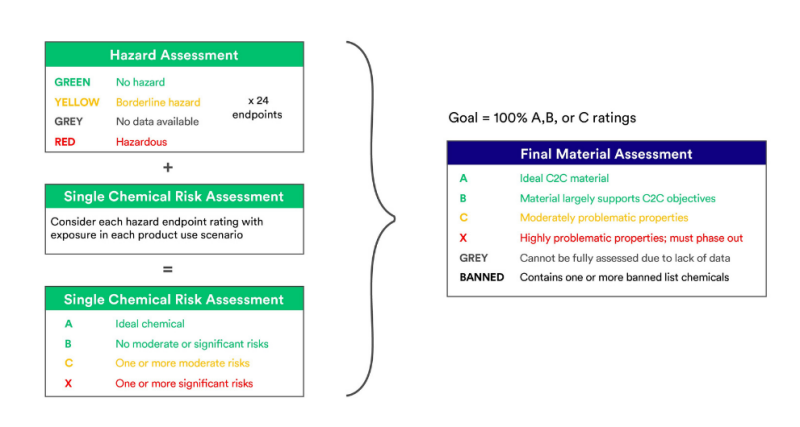The Cradle to Cradle Certified Material Health Assessment Methodology

The goal of the Cradle to Cradle Certified Material Health Assessment is to assign an A (ideal), B (preferred), C (acceptable), X (significant risks) or GREY (insufficient data) rating to each homogeneous material subject to review in the product (present at 100 ppm or higher) using the following three steps:
- Conduct Hazard Assessment
- Conduct Exposure Assessment & Assign Chemical Risk Ratings
- Assign Material Assessment Rating
The hazard assessment is conducted against 21 human and environmental endpoints by examining all relevant sources including measured data from experimental studies and the scientific literature, authoritative lists, and information derived from models and chemical analogs. Hazard ratings are assigned to each endpoint with Red, Yellow, Green or Grey.
This is followed by an exposure assessment, with the goal to determine which chemical hazards (Red) and data gaps (Grey) can be disregarded given the material and product context. In our Program approach it is not a traditional exposure assessment, no attempt is made to quantify the magnitude of any potential exposure.
The goal is to assess whether or not relevant avenues of exposure exist across the following exposure scenarios:
- All final manufacturing processes
- All intended and likely unintended use scenarios
- All intended and likely unintended end-of-use scenarios
This information is then rolled-up into a material assessment.
The ideal chemical ‘A’ would have no toxicity data gaps AND have no hazards whatsoever, irrespective of use. However, such substances are rare, and to obtain an A rating, ALL the substances assessed within a material would need to receive an A-rating. In practice, this hardly happens, so the focus of the program is on moving away from X and Grey materials towards this ideal.

